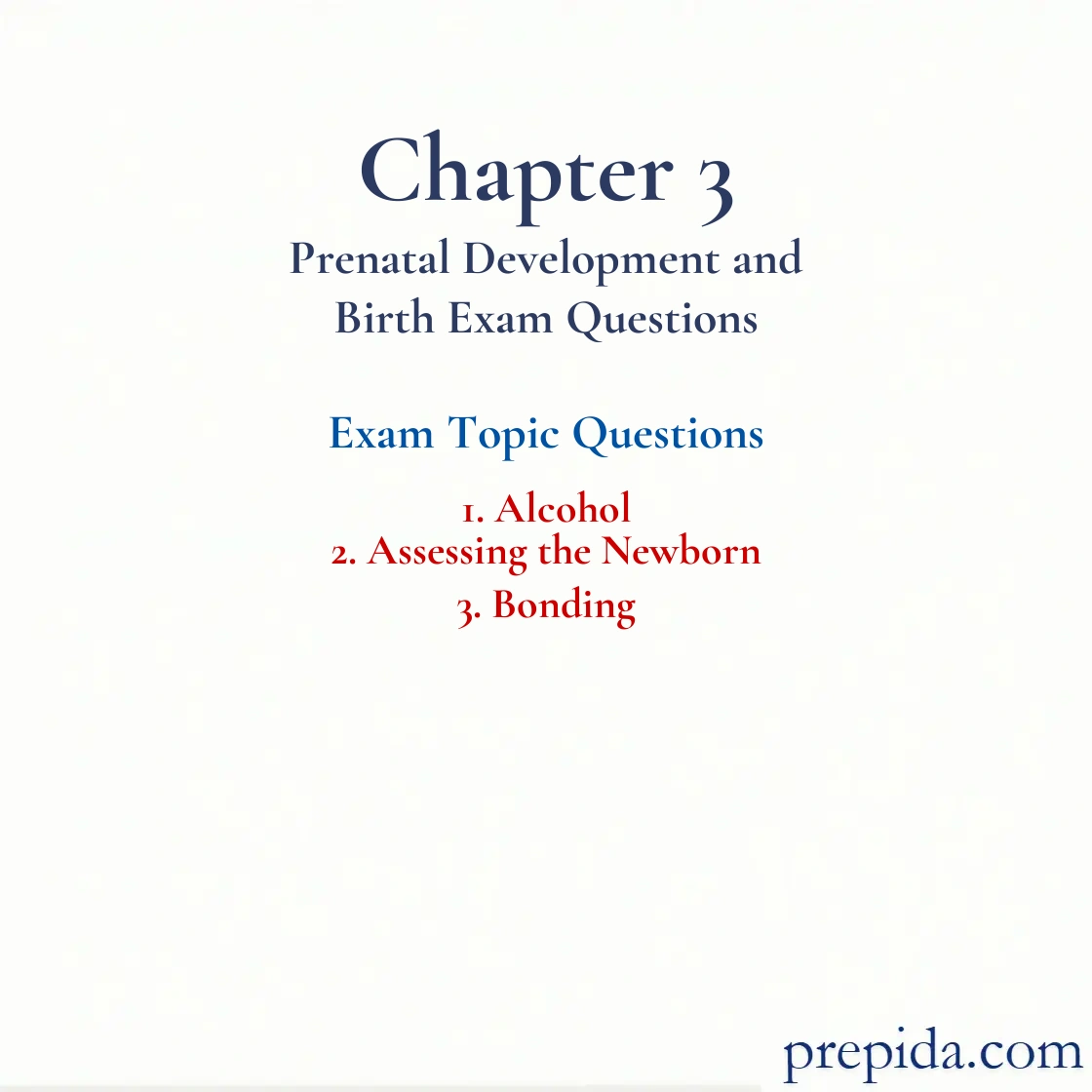
Which of the following is the U.S. Surgeon General's recommendation regarding alcohol intake during pregnancy?
- It is wise to consume alcohol in moderation at the time of conception.
- One or two servings of beer or wine a few days a week can have positive effects on the fetus.
- No alcohol should be consumed during pregnancy.
- One or two servings of hard liquor a few days a week can have positive effects on the fetus.
Fetal Alcohol Spectrum Disorders (FASD): A cluster of abnormalities that appear in the offspring of some mothers who drink alcohol heavily during pregnancy.
Jessica is a 25-year-old woman who often drinks alcohol. Now that she is pregnant, her doctor has advised her to avoid alcohol as it has been proven to cause abnormalities in the offspring. According to recent research, which of the following is a known abnormality?
- lower birth weight
- withdrawal symptoms
- lower quality of reflexes at one month of age
- facial deformities
A pediatrician is testing baby Rosaria. The doctor assesses Rosaria's neurological development, reflexes, and reactions to people and objects. Rosaria's pediatrician is using the
- Apgar Scale.
- Infant IQ test.
- Brazelton Neonatal Behavioral Assessment Scale.
- Wechsler Intelligence Scale for Children.
Brazelton Neonatal Behavioral Assessment Scale (NBAS): A measure that is used in the first month of life to assess the newborn’s neurological development, reflexes, and reactions to people and objects.
Brenda's baby was born just minutes ago, and the doctor is checking the baby's heart rate, respiratory effort, body color, reflex irritability, and muscle tone. Brenda's baby is being tested with the
- Apgar Scale.
- preterm outcome test.
- Rogers-Randall Assessment.
- Brazelton Neonatal Behavioral Assessment Scale.
Apgar Scale: A widely used method of assessing the health of newborns at one and five minutes after birth. The Apgar Scale evaluates an infant's heart rate, respiratory effort, muscle tone, body color, and reflex irritability.
Which of the following statements is true of the condition of a newborn infant based on the Apgar Scale reading?
- A total score of four and below is considered normal and indicates that the baby is healthy.
- A total score of one to three indicates that the risk of developing attention deficit hyperactivity disorder (ADHD) in childhood is absent.
- A total score of seven to ten indicates that the newborn's condition is good.
- A total score of five and above indicates an emergency and that the baby may not survive.
Apgar Scale: A widely used method of assessing the health of newborns at one and five minutes after birth. The Apgar Scale evaluates an infant's heart rate, respiratory effort, muscle tone, body color, and reflex irritability.
The Apgar Scale is a method used to assess the health of newborns. A score of three would indicate
- that the newborn's condition is good.
- that there may be some developmental difficulties.
- an emergency because the baby's survival is in doubt.
- that the evaluator has not made a proper reading.
Apgar Scale: A widely used method of assessing the health of newborns at one and five minutes after birth. The Apgar Scale evaluates an infant's heart rate, respiratory effort, muscle tone, body color, and reflex irritability.
In assessing the health of newborns, the ________ identifies high-risk infants who need resuscitation.
- Rogers-Randall Assessment
- Brazelton Neonatal Behavioral Assessment Scale
- Wechsler Infant Intelligence Scale
- Apgar Scale
Which of the following is evaluated by the Apgar Scale?
- the newborn's kidney function
- the newborn's birth weight
- the newborn's height
- the newborn's heart rate
The Apgar Scale is especially good at determining
- the severity of limb deformities of the newborn.
- the newborn's susceptibility to common postnatal complications.
- the newborn's ability to cope with the stress of delivery.
- the newborn's lactose tolerance.
The Brazelton Neonatal Behavioral Assessment Scale is typically performed within ________ after birth.
- one to two months
- 24 to 36 hours
- two to five days
- one to two weeks
Brazelton Neonatal Behavioral Assessment Scale (NBAS): A measure that is used in the first month of life to assess the newborn’s neurological development, reflexes, and reactions to people and objects.
The ________ is designed to gauge normal, healthy, full-term infants and is used as a measure in many studies of infant development.
- Brazelton Neonatal Behavioral Assessment Scale
- Apgar Scale
- Infant IQ test
- Wechsler Intelligence Scale for Children
Brazelton Neonatal Behavioral Assessment Scale (NBAS): A measure that is used in the first month of life to assess the newborn’s neurological development, reflexes, and reactions to people and objects.
Michael and Jessica are having their first child and have told their physician they would like a rooming-in arrangement. This means that
- Michael can stay overnight in Jessica's room.
- Jessica's hospital room will be more like a nursery.
- Jessica's baby will stay in her room most of the time during its hospital stay.
- Jessica will stay in the hospital for the first two months after pregnancy.